Similar fish basins sold at auction include one from the Juan Jose Amezaga and Maria Dolores Feijoo Collection sold at Christie's Paris, 7 December 2007, lot 38 and another from the C. Ruxton and Audrey B. Love Collection sold at Christie's New York, 20 October 2004, lot 611 (although the background of the outside is predominantly white). A pair of Qianlong-marked cloisonne basins of similar size and interior decoration, but with a lotus pond design on the exterior, was sold at Christie's Hong Kong, 27 October 2003, lot 735.
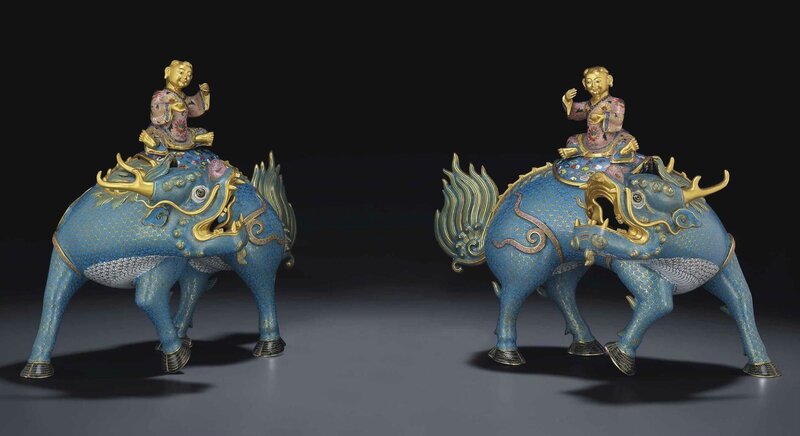


Lot 281. A pair of cloisonné and champlevé enamel 'qilin and boy' censers, China, Qing dynasty, Qianlong-Jiaqing period (1736-1820). Estimate €70,000 - €90,000 ($79,405 - $102,093). Price Realised €127,500 ($144,631). Photo Christie's Image Ltd 2016
The two censers are cast in mirror image as a striding blue qilin with head turned sharply to the side towards the boy seated on its back. The qilin has its mouth open in a roar, with champleve enamel brows, mane and tufts of the tail. Its back is topped by a saddle-like attachment decorated with multi-coloured ruyi clouds upon which the boy is seated dressed in pink robes with floral scrolls and holding an ingot in his right hand. 14 1/2 in. (37 cm.) long, 11 in. (28 cm.) overall high
Provenance: With A & J Speelman Ltd., London.
Dr Samuel and Annette Mandel collection, Palm Spring, Florida, United States of America.
Christie's Hong Kong, Masterpieces of the Enameller's Art from the Mandel collection, 30 May 2012, lot 3914.
Notes: The theme of boy riding on a qilin provides the rebus qilin songzi, 'may the qilin bring you a son', a common wish for the perpetuation of many generations of sons. A pair of biscuit enamelled examples dated to Kangxi period which probably is a prototype of the present lot, from the Richard Bennett Collection, was sold at Christie's Cowdray Park sale, 13-15 September 2011, lot 447.
A similar censer of this subject formerly in the T.B. Kitson Collection, but with the body of the animal picked out in white rather than turquoise, was sold at Sotheby's London, 7 June 1967, lot 268. Another slightly smaller pair (35 cm. length) was sold at Christie's Hong Kong, 2 November 1999, lot 808.

Lot 282. A large cloisonné enamel basin, China, 17th century. Estimate €10,000 - €15,000 ($11,344 - $17,015). Price Realised €61,500 ($69,763). Photo Christie's Image Ltd 2016
The centre of the interior is decorated with the idyllic palace of Xiwangmu, the Daoist Mother of the West in the Kunlun mountains, within a narrow foliate border below a band of lotus scroll in the deep well. The everted rim is enamelled with cartouches of lotus, peony, prunus and magnolia reserved on a diaper ground, all against a turquoise ground. 20 5/8 in. (52.5 cm.) diam.
Provenance: Acquired from a family from the East of France in the 2000s.
Note: Compare to a similarly decorated cloisonné basin, dated second half of seventeenth century, in the Uldry Collection, illustrated by H. Brinker and A. Lutz in Chinesisches Cloisonne Die Sammlung Pierre Uldry, Museum Rietberg, Zürich, 1985, pl. 162.

Lot 283. A large cloisonné enamel 'lotus' bottle vase, tianqiuping, China, Qing dynasty, 17th-18th century. Estimate €8,000 - €12,000 ($9,075 - $13,612). Price Realised €85,500 ($96,988). Photo Christie's Image Ltd 2016
The vase is entirely decorated with a lustrous, multi-coloured lotus and foliage meander against a turquoise ground. 27 3/8 in. (69.5 cm.) high
Provenance: Acquired from a family from the East of France in the 2000s.
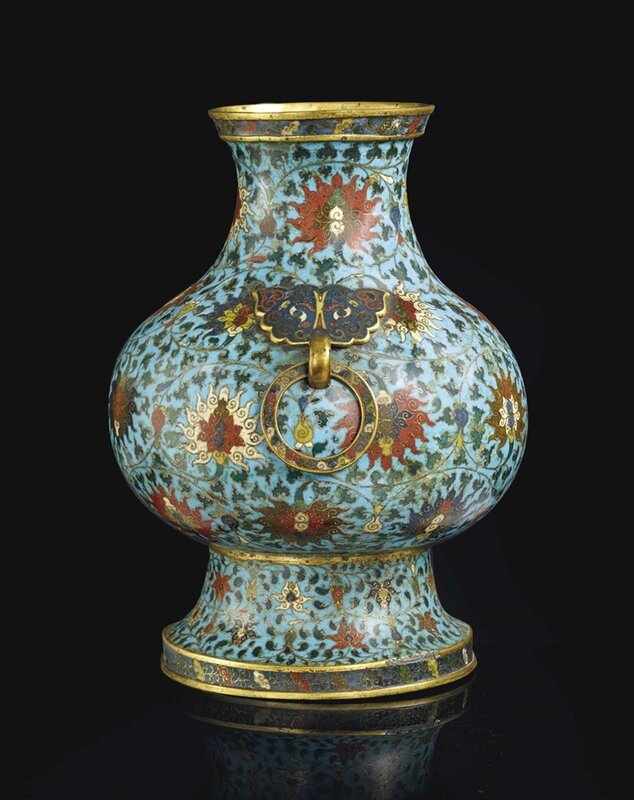
Lot 284. A large cloisonné enamel 'lotus' vase, hu, China, 17th century. Estimate €12,000 - €18,000 ($13,612 - $20,419). Price Realised €85,500 ($96,988). Photo Christie's Image Ltd 2016
The vase is enamelled on the slightly compressed globular body with multi-coloured lotus blooms supported on and pendent from scrolling leafy vines, above overlapping lappets and below ruyi and lingzhi scroll motifs around the flaring mouth rim. The shoulder is surmounted by a pair of taotie mask handles suspending loose rings. 16 7/8 in. (43 cm.) high
Note: A near identical hu-shaped vase, dated first half of 17th century, is illustrated by H. Brinker and A. Lutz, Chinese Cloisonne: The Pierre Uldry Collection, Zurich, 1989, pl. 124.

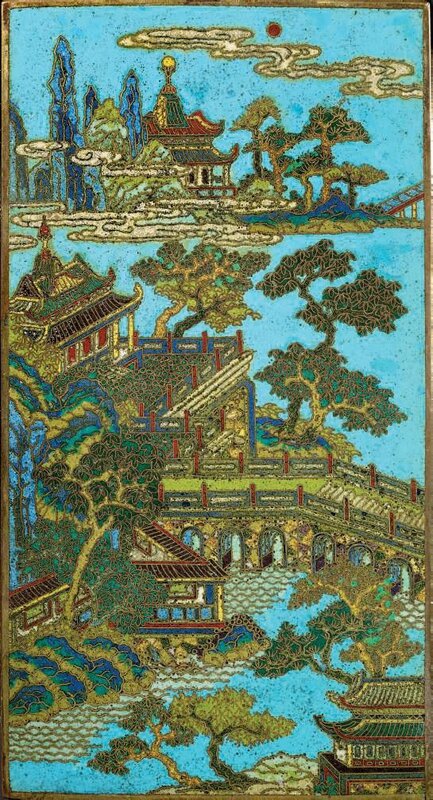
Lot 285. A rare cloisonné enamel rectangular cong-form vase, China, Qing dynasty, Qianlong period (1736-1795). Estimate €40,000 - €60,000 ($45,375 - $68,062). Price Realised €157,500 ($178,662). Photo Christie's Image Ltd 2016
Of square section reminiscent of a cong shape, the four sides are finely decorated with a continuous scene of pavilions by a lake in an idyllic landscape amidst trees and rockwork. The neck and the pedestal foot are decorated with archaistic stylised cicada blades. 15 ¾ in. (40 cm.) high
Provenance: Sotheby's London, 14 November 1967, lot 46.
Collection of Dr. Gordon Fryers (1922-2008) and Dr. Rosemary Fryers (1922-1994), and thence by descent to the present owner.
Note: Compare to a smaller vase of this shape, decorated on the sides with different scenes of pavilions in mountainous landscapes, illustrated in The Complete Collection of Treasures of the Palace Museum - 43 - Metal-bodied Enamel Ware, Hong Kong, 2002, p. 153, no. 145, which is dated to mid-Qing dynasty.

Lot 351. A cloisonné enamel vase, gu, China, 17th century. Estimate €4,000 - €6,000 ($4,537 - $6,806). Price Realised €23,750 ($26,941). Photo Christie's Image Ltd 2016
The vase is enamelled in bright tones with taotie masks, and a band of upright cicada blades at the corners of the trumpet mouth enclosing chilong motifs. The mouth is decorated with a pair of confronting phoenix on both the exterior and interior. The exterior is entirely applied with vertical notched flanges. 15 7/8 in. (40.5 cm.) high
Provenance: Collection of the late Laurent Kadé (1933-1990), France, and thence by descent to the present owner.
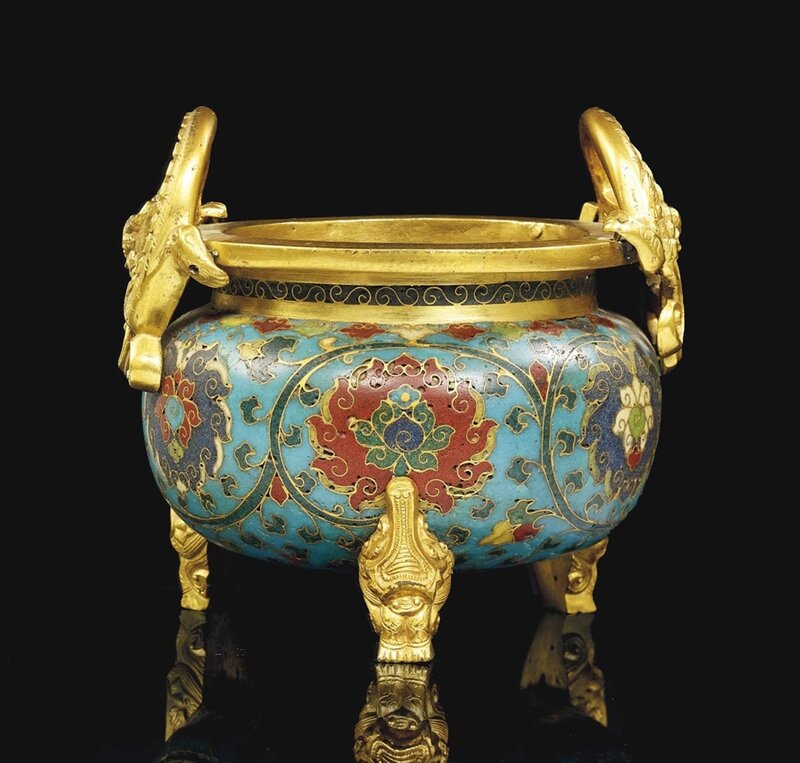
Lot 354. A large cloisonné enamel 'lotus' tripod censer, China, Ming dynasty, 17th century. Estimate €8,000 - €12,000 ($9,075 - $13,612). Price Realised €10,000 ($11,344). Photo Christie's Image Ltd 2016
The globular body is raised on three gilt-bronze elephant supports and is decorated around the sides with six large lotus blossoms borne on scrolling leafy tendrils, with a large multicolored, spiralled flower head in the centre of the base, and with a pair of gilt-bronze handles formed as coiled chilong ; replacements. 6 5/8 in. (17 cm.) high
Provenance: Collection of the late Laurent Kadé (1933-1990), France, and thence by descent to the present owner.
Note: A smaller cloisonné enamel censer, featuring comparable gilt-bronze feet and handles, although decorated with cranes amidst clouds, is illustrated by H. Brinker and A. Lutz in Chinese Cloisonné: The Pierre Uldry Collection, Zurich, 1989, no. 56, where it is dated first half 16th century. See a similar tripod censer, dated 16th-17th century, sold at Christie's, New York, 15 September 2011, lot 1203.
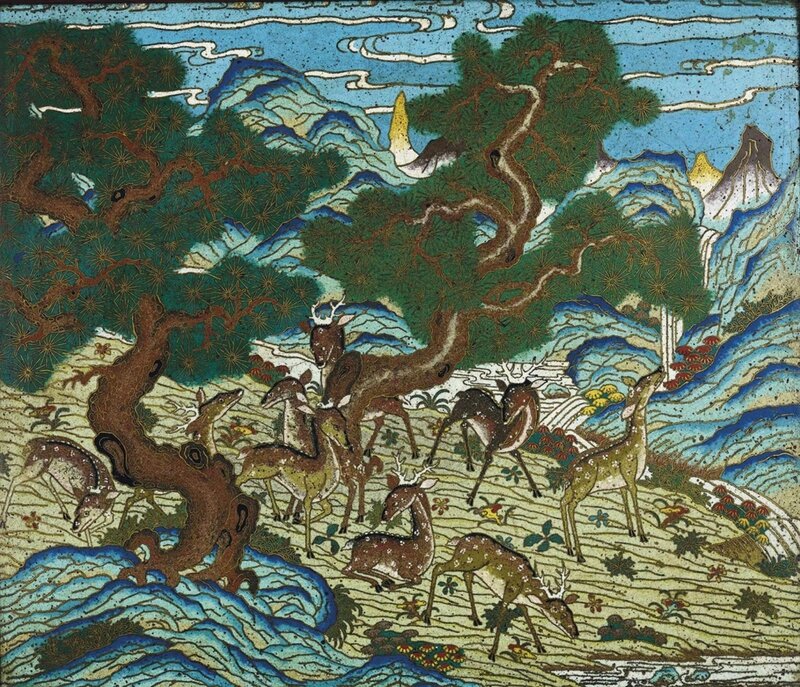
Lot 355. A rare cloisonné enamel 'Nine-deer' panel, China, Qing dynasty, Qianlong period (1736-1795). Estimate €25,000 - €35,000 ($28,359 - $39,703). Price Realised €55,500 ($62,957). Photo Christie's Image Ltd 2016
The rectangular panel is finely decorated in vivid enamels against a bright turquoise ground with nine deer, their fur picked out in white, pink and olive-brown, shown grazing, gamboling and resting in a lush landscape amidst pine trees, lingzhi, with a meandering stream flowing through blue-shaded rocks from the high mountains in the distance. 16 ¾ x 14 ½ in. (42,5 x 37 cm.), wood frame
Provenance: Collection of the late Laurent Kadé (1933-1990), France, and thence by descent to the present owner.
Notes: The deer symbolises both career advancement and longevity, while the pine trees and lingzhi constitute additional symbols of long life.
See two cloisonné enamel vessels decorated with deer in landscapes, illustrated by H. Brinker and A. Lutz, Chinese Cloisonné: The Pierre Uldry Collection, 1989, no. 322, a large fish basin, and no. 323, a tripod censer.
Deer are often painted on enamelled porcelain of the Qianlong period. See a porcelain example, in the Shanghai Museum, illustrated in China Museum Collections, Jingdezhen Polychrome Ceramics, vol. 21, no. 103; another from the Grandidier collection in the Musée Guimet, Paris, illustrated in Oriental Ceramics, The World's Great Collections, vol. 7, no. 190

/https%3A%2F%2Fprofilepics.canalblog.com%2Fprofilepics%2F1%2F0%2F100183.jpg)
/https%3A%2F%2Fstorage.canalblog.com%2F03%2F02%2F119589%2F96711876_o.jpg)
/https%3A%2F%2Fstorage.canalblog.com%2F11%2F31%2F119589%2F94773502_o.jpg)
/https%3A%2F%2Fstorage.canalblog.com%2F20%2F83%2F119589%2F94772815_o.jpg)
/https%3A%2F%2Fstorage.canalblog.com%2F26%2F72%2F119589%2F75604929_o.jpg)
/https%3A%2F%2Fstorage.canalblog.com%2F59%2F60%2F119589%2F26458628_o.jpg)

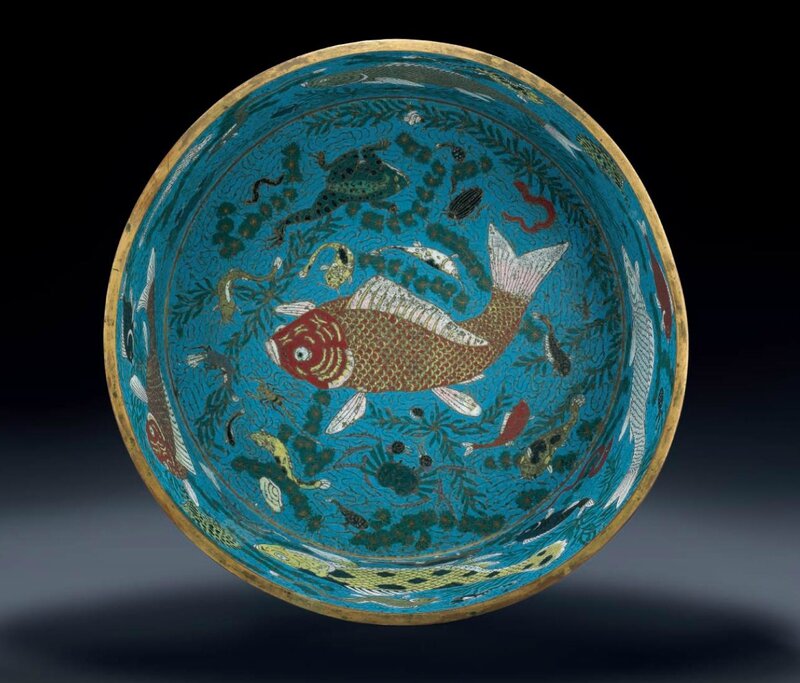













/http%3A%2F%2Fstorage.canalblog.com%2F40%2F76%2F119589%2F95676154_o.jpg)
/http%3A%2F%2Fstorage.canalblog.com%2F82%2F33%2F119589%2F95307203_o.jpg)
/http%3A%2F%2Fstorage.canalblog.com%2F75%2F68%2F119589%2F92470034_o.jpg)
/http%3A%2F%2Fstorage.canalblog.com%2F23%2F54%2F577050%2F39456672_p.jpg)